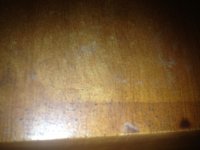charley1968
Member
- Joined
- Sep 20, 2013
- Messages
- 491
Hi all!
I want do redo our kitchen table-top and i need some advice on how to remove the lacquer on it. Then i plan to sand it to a 240grit and oil it Surfix indoor heavy duty oil.
First things first: i' m not sure how the surface of the table was treated but to me it appears not to betreated with oil. It's somewhat harder than the wood, so i guess it's some kind of lacquer. I plan to remove it with Granat 80grit on a low speed setting. Would Granat be the correct choice, being made especially for VOCs/shellac? Do you recommend a coarser grit?
Once i've removed the whatever-it-is, i start sanding the wood 80-120-180 ( does 150 make a difference?), water it and give i a prefinal go with 240. Then i do the Surfix-thing with a slight rub of 320grit after the first oil-layer has dried.
Does that sound like an ok plan or will i end up with gummed-up sandpaperdiscs , horrible surface and the need to buy a new kitchen table?
I want do redo our kitchen table-top and i need some advice on how to remove the lacquer on it. Then i plan to sand it to a 240grit and oil it Surfix indoor heavy duty oil.
First things first: i' m not sure how the surface of the table was treated but to me it appears not to betreated with oil. It's somewhat harder than the wood, so i guess it's some kind of lacquer. I plan to remove it with Granat 80grit on a low speed setting. Would Granat be the correct choice, being made especially for VOCs/shellac? Do you recommend a coarser grit?
Once i've removed the whatever-it-is, i start sanding the wood 80-120-180 ( does 150 make a difference?), water it and give i a prefinal go with 240. Then i do the Surfix-thing with a slight rub of 320grit after the first oil-layer has dried.
Does that sound like an ok plan or will i end up with gummed-up sandpaperdiscs , horrible surface and the need to buy a new kitchen table?

